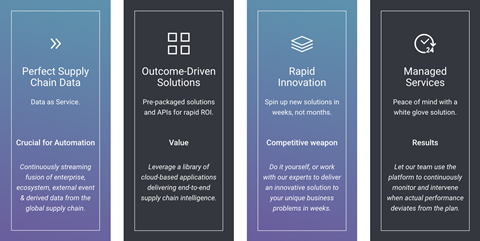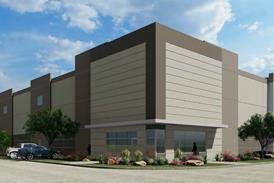PARTNER CONTENT
This content was produced by Automotive Logistics in partnership with TransVoyant
Real-time and predicted intelligence from continually streaming global data is the only way to get ahead in the automotive supply chain


The recent semiconductor crises revealed some surprising blind spots in the world’s most complex supply network. That’s because the automotive supply chain has been operating with severely limited actionable intelligence derived from future flow and behaviour. Although managers may know the location of inventory at any one point during this process, that isn’t sufficient to continually understand and predict flow and behaviour for parts, subassembly, and finished goods.
Supply chain visibility is useless unless it helps managers respond effectively, or even block disruption in advance. Leading automotive companies are leveraging more complete, real-time data to shift from reactive to proactive supply chain management.
Legacy system problems
AI can now help supply chain managers leverage current and predicted future events to sense, anticipate and intervene on supply chain disruptions outside of their planned operations.
“Here’s the problem with legacy systems,” says Allison Fowler, chief product officer at TransVoyant, which leads the supply chain predictive analytics space. “Companies spend most of their time and money on the functionality to make silos inside a single company more efficient. Unfortunately, most legacy planning system failures come from disruptions across silos and across the global supply chain ecosystem.”
Variability will always exist in demand forecasts, but unforeseen disruptions to supply, manufacturing and logistics networks – such as widespread semiconductor shortages – will destroy plans that only account for demand variability. In other words, acceptable inventory and capacity buffers can be positioned to account for demand variability, but global interdependent supply chain disruptions put the entire business at risk.
Outdated visibility data leaves supply chain practitioners firefighting disruptive events in a random order because their systems and business processes do not enable them to act in the moment across internal and partner functional silos. The only way to avoid disruption is to rapidly sense, predict, and respond to continuous real-time supply events.
Supplier innovation to avoid fees
How does this innovative predictive and prescriptive ecosystem work? One major tier one tyre supplier uses TransVoyant’s real-time flow and behaviour data to provide insights that track global raw materials and finished goods across multiple modes, and multiple geographies. The data include inbound volume tracking for containers into each supplier and their logistic service provider facilities, plus an end-to-end predictive time of arrival that monitors each leg for lateness alerting, facility replanning and measurement (versus contractual transit time by carriers).
This P2E platform is pre-integrated with the supplier’s systems, logistics service providers, and port terminals for enhanced visibility and rapid implementation. As a result, the supplier is now avoiding demurrage of shipments and detention of containers and benefiting from improved inventory planning supported by historical and predicted lead times and variability. Carrier management is easier thanks to insights into contract lead times versus actual deliveries. A tariff and duty application created better total landed cost, and TransVoyant’s inbound raw material tracker is helping the tyre supplier avoid plant disruption or rescheduling.
Over time, this supplier has been able to innovate new use cases with TransVoyant, from improving supply chain flow and behaviour to include such benefits as last free day, avoiding demurrage fees, tax and duty reduction, ecosystem KPIs, and planning and executing flex warehouse requirements. This rapid supply chain innovation creates ever-increasing value along with new applications, and cross-company internal and external user groups.
Brake parts company identifies demand change
For a global brake parts manufacturer, TransVoyant provides continuous predictive analytics based on failure rates derived from live and historical condition and usage data.
Brian Lindenmeyer, vice-president of growth at TransVoyant, explains how new insights completely shifted this client’s planning.
“In the past, this industry predicted brake failures on a particular type of vehicle from only past maintenance,” Lindenmeyer says. “For instance, historical maintenance data indicates they should last 60,000 miles, but we are seeing brakes fail at 45,000 miles with correlation to different environmental conditions, usage patterns and geographic locations. With that information we can alert dealers, customers, distributors, part planners and internal engineering.”
Lindenmeyer says the predictions and proactive intervention are good for the manufacturers and those who distribute to the dealer and repair networks to understand so everyone can deliver brake parts in a timely fashion. Not having the parts on hand risks resulting in a lost sale at the point of service.
“Once we have global flow and behaviour switched on, we are able to look at where the client is spending excess money or missing revenue opportunities,” says Fowler. “Then we can add flex warehousing to scale up for spikes in demand, or can we act on the live and predictive information around early part failures impacting our customers and delivery network.”
From there TransVoyant grows customer value through rapid innovation and productization so that each delivered business case funds future digital innovation.
Turning supply chains into competitive weapons
TransVoyant provides businesses and governments with a real-time and predicted intelligence platform to automatically derive problems, opportunities and solutions based on continually streaming internal and external global supply chain data. TransVoyant’s P2E platform auto-indexes tens of thousands of data sources, creates correlations and makes predictions.
It is the only commercial solution indexing massive amounts of external and internal supply chain data and simultaneously running complex machine learning and artificial intelligence to identify current or future needles in the haystack.
The P2E solution emerged from the United States national security network, applying the same conventions to identify and interdict threats and risks to the US and its allies. The platform combines continuous data streaming, indexing, and the ability to run complex distributed models in real-time to identify supply chain risk, problems and opportunities to prescribe alternative courses of action.
Sign Up for TransVoyant’s webinar with Bridgestone here
The TransVoyant platform, capabilities, and services provide four pillars that drive supply chain value.

The first pillar is the fusion of external, ecosystem, enterprise, and derived data from diverse live sources including satellites, IoT devices, modern APIs, legacy business systems, manufacturing execution systems, manual web forms, spreadsheets, global social applications, and more. The TransVoyant platform rapidly integrates to any source supporting all levels of customer or ecosystem partner maturity.
“With our national security history, we have been ingesting and curating thousands of streams of live data for over 12 years” says Fowler. “That’s over a decade of machine learning and training for more efficient and accurate AI models.”
The second pillar is a continually growing library of pre-built TransVoyant applications cutting across customer functional silos, ecosystem partners, and end users. This library contains hundreds of applications. The data powering the applications always flows, and models continually run to keep complex global organizations and their ecosystem partners focused on tomorrow’s problems and opportunities.
The third pillar is the capability to rapidly create new applications on TransVoyant’s supply chain innovation platform. By taking advantage of curated live and historical data, the no-code platform tooling, and the existing applications, clients leverage the only global innovation platform built with end-to-end supply chain at its core to rapidly create cross-functional, global ecosystem, and customer capabilities.
Finally, the fourth pillar provides all TransVoyant capabilities as a managed service for those companies that want a partner to manage ecosystem performance and actively intervene in current and predicted problems across their global supply chain. This service has recently expanded to include the physical network to store, move and deliver for TransVoyant clients in selected industries.
We’ve seen automotive companies lead global change in supply chain management, and that leadership is driving the shift to leveraging prescriptive insights. While yesterday’s supply chain managers knew the location of inventory at any one point, that knowledge alone isn’t sufficient to continually understand and predict flow and behavior for parts, subassembly, and finished goods. Today’s supply chain managers need prescriptive insights to guide proactive decisions.
Even the best-laid plans quickly become obsolete without real-time information about events and behavior. And while network visibility is helpful, visibility by itself only enables reaction, not proactive risk prevention.

























![Global[1]](https://d3n5uof8vony13.cloudfront.net/Pictures/web/a/d/s/global1_726550.svgz)














No comments yet